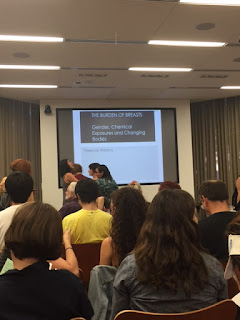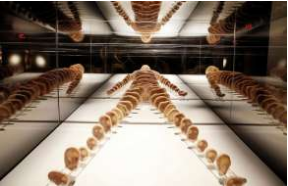Event 2
 Last week I was able to
attend the keynote address for the Chemical Entanglements: Gender and Exposure
Conference. The keynote speaker was Florence Williams, a writer and
editor of various newspapers, and her presentation focused on the topic “The
Burden of Breasts: Gender, Chemical Exposures, and Changing Bodies”.
Last week I was able to
attend the keynote address for the Chemical Entanglements: Gender and Exposure
Conference. The keynote speaker was Florence Williams, a writer and
editor of various newspapers, and her presentation focused on the topic “The
Burden of Breasts: Gender, Chemical Exposures, and Changing Bodies”.
While there were some
artistic elements to her address, it largely centered on the chemical effects
(which lead to medical issues) that many everyday products have on the human
body, specifically women’s breasts. After hearing of studies into the
alarmingly high amounts of PBDEs, compounds found in flame retardants, found in
breast feeding moms in Europe, Ms. Williams decided to send in her own breast
milk sample to a European lab to see how her levels compared to those of
European moms. What she, and other Americans found out, was that levels
of PBDE found in the breast milk of breastfeeding American moms was ten times
higher than that of the average European. Californians have it particularly
bad, averaging ten times more PBDE in their breast milk than the average
American. This is problematic due to the toxicity of PBDE.
PBDE, however, wasn’t
the only hazardous chemical in high dosage that Ms. Williams mentioned in the
female breast. The lab that she sent her sample to also reported seeing
large traces of perchlorate and DDT in female breast milk. Perchlorate is
a chemical found in rocket fuel that is both toxic in water and harmful to the
environment, while DDT is an insecticide that was commonly used until Rachel
Carson’s Silent Spring published its hazardous effects on the
environment and links to cancer in 1962.
In bringing the hazards of such chemicals to light, Ms. Williams
stressed the importance for women to be aware of the dangers that many women’s
products are placing on the female body.
With the topic being
breasts, Ms. Williams did touch on how the depiction of breasts has changed in
the media over time. Long ago, people were fascinated with smaller
breasts, and artists depicted the ideal woman as someone with small breasts.
The dawn of the television age, however, largely changed this perception.
All of a sudden, popular culture was fascinated in large breasts, and
artistic works began to connect sexuality with them. While this artistic
element was mentioned, the focus of Ms. Williams’ presentation was on the
harmful chemicals that female breasts (in comparison to male breasts) are, and
have been, subjected to.
It was a fascinating
presentation, and one that I certainly did not know what to expect going into. Ms. Williams was a captivating speaker and I would highly recommend
attending one of her presentations.
 |
| Florence Williams Background |
 |
| Me with a member of the hospitality staff |



Comments
Post a Comment